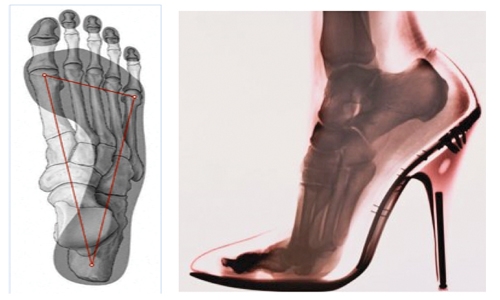Are you suffering from Plantar fasciitis
Of all primates, humans are the only obligate bipeds. Highly specialized adaptations, especially in the lower limb, characterize this unique form of locomotion. The foot is particularly specialized in both its anatomy and its function. This makes perfect sense, because in developing bipedal locomotion, the foot becomes the only structure that directly interfaces with the ground, and subsequently is under strong selection pressure to deal with both balance and propulsion in a highly efficient way.
Therefor the construction of the foot is unique, elastic and stable. It is a construction of two arches which convergent together so the foot can rest on three pillars: the calcaneus, the head of metatarsal 1 and 5. The ligaments and the muscles of the foot and also of the calve fix these two arches in a dynamic way so every time the foot can stand completely on the ground.
This construction is in our gens. In generally, adults make one to two million steps within a quarter of a year. We do these mostly on plain and hard grounds in shoes which keep the feet in a fixed position. And - we imply that these tortures will be accepted by us without any complains.
First, the transverse arch lowers down. This starts normally at the end of the growth period and in the most cases nobody realizes this. But in reality more things change. The heads of the metatarsals 2, 3 and 4 needs more space between metatarsal 1 and 5 when they lower, so they push these metatarsals to the side. Result is the pulling directions of tendons change. The first toe turns inside; a hallux valgus develops. The more the head of metatarsal 1 is forced to move to medial the extensor and flexor tendon slip from the middle of the metatarsal-phalangeal joint. At that point conservative methods will never be successful to restore a regular situation. These changes are mostly painful. The pain locates at the medial edge of the forefoot, at the bottom of the forefoot but also at the bottom of the heel at the insertion of the elongated plantar fascia. This is called plantar fasciitis.
What can be done to solve the problems?
In the beginning, when pain is mild or only on and off, external supports, so called insoles which support the arches will help the foot to stay stable and secure and keep the bones in the right position. This is a passive support therefore physiotherapy and own exercises are necessary to stabilize the power of the muscles. If this is not enough, only surgical treatments can help. The reason is to reconstruct the transverse arch and to reposition the head of metatarsal 1. Metatarsal 1 has to be cut and the distal part with the head has to be shifted towards metatarsal 2 and also downwards. These parts have to be fixed, mostly with small titanium screws or plates. After surgery mobility is not restricted, but for a minimum of 6 week weight load is not possible. Every activity even exercises have to be done with a so called forefoot reliever shoe. X-rays after 6 weeks prove if the bone is fused, so normal living can restart. The surgery itself last about 90 minutes and normally is done in general anaesthesia. The patient is able to leave the hospital the next day after surgery. The post-operative pain is moderate and can be covered with oral pain relievers. The remaining scar normally remains as a small line. It is not necessary to remove the implants.
Check out our Instagram account @germanorthobahrain for more helpful information.
Dr. Manfred Kreibich
Consultant Ortopaedic and Trauma Specialist Hand and Foot
Related Posts


